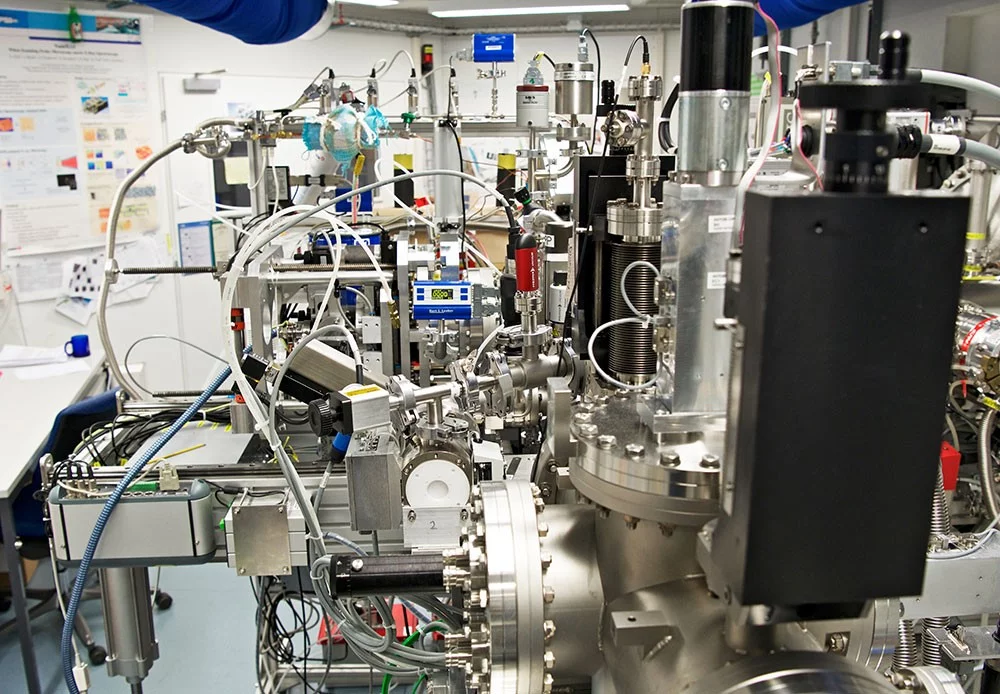Ambient-pressure X-ray photoelectron spectroscopy at SLS’ newest endstation has revealed surprising redox chemistry at solvating particle surfaces. The findings are published in Science.
What happens at the interface between gases and aerosol particles is key to many atmospheric processes, such as cloud formation. Aerosol particles from natural emissions or man-made pollution are important, even if they are not visible, because they have surfaces in an atmosphere that otherwise would only consist of gases. A collaboration between University of Gothenburg, PSI and Qatar Environment and Energy Institute has now found evidence that when these surfaces begin to absorb water and dissolve, new and previously undiscovered chemistry can take place. The results may be important for atmospheric chemistry and could be useful for wastewater treatments and other industrial technologies.
Surprising discovery of new chemistry
Because the interactions between gases and particles occur on a molecular level, correctly understanding the chemistry of the atmosphere requires techniques that elucidate the microscopic surface properties involved in this interaction. The unique set-up at PSI gives the ability to probe with X-ray photoelectron spectroscopy the physico-chemical properties of a salt, deposited on a surface under carefully varied humidity. Combining this with molecular dynamics simulations, the team investigated redox chemistry occurring at a solvating inorganic aerosol surface. For this purpose, ammonium sulfate was used as a proxy for atmospheric inorganic aerosol.
In the new article in the journal Science, the researchers describe that when a surface of ammonium sulphate solvates, it promotes sulphate-reducing ammonium oxidation.
The discovery is surprising, because this reaction ordinarily requires extra energy to overcome a barrier and therefore does not occur spontaneously.
“It was a surprise to see the reaction occur, but we came to understand that the water-soluble salt surface made the reaction possible. This has led us to rethink the catalytic effects of surfaces, where some reactions actually can be promoted in the right conditions,” says Xiangrui Kong, researcher at the University of Gothenburg, lead author of the study and previous member of the group of Prof. Markus Ammann at PSI.
Possible benefits for cost-effective industrial and environmental applications
The research has ramifications for our understanding of the atmospheric sulphur cycle and the occurrence of other important compounds involved in many chemical reactions in the atmosphere.
The sulphate-reducing ammonium oxidation reaction that was observed may also be useful for sewage treatment, for example, and other industrial applications. Biocatalysts or other expensive methods are currently required to activate such reactions. According to the researchers, the new mechanism indicates that cost-effective applications may be developed based on this new knowledge.
“As we began to realise our results, it took us quite some time to understand what we were observing and why, but the result is exciting and motivates us to dig deeper into how surface phase transitions can change the chemical environment,” says Erik S. Thomson, senior lecturer at the University of Gothenburg and one of the authors behind the study.
The new study is the fruit of a collaboration between researchers from the University of Gothenburg and researchers from the Paul Scherrer Institute in Switzerland and the Qatar Environmental and Energy Research Institute. The observations were made at the Swiss Light Source research facility in Switzerland and theoretical calculations support the experimental observations and the proposed reaction mechanism.
Based on a media release from University of Gothenburg with additions from Paul Scherrer Institute / Miriam Arrell
Contact
Dr. Luca Artiglia
Laboratory for Catalysis and Sustainable Chemistry
Paul Scherrer Institute
5232 Villigen
Switzerland
luca.artiglia@psi.ch
Prof. Markus Ammann
Laboratory of Environmental Chemistry
Paul Scherrer Institute
5232 Villigen
Switzerland
markus.ammann@psi.ch
Original Publication
Xiangrui Kong, Dimitri Castarède, Erik S. Thomson, Anthony Boucly, Luca Artiglia, Markus Ammann, Ivan Gladich and Jan B.C. Pettersson
A surface-promoted redox reaction occurs spontaneously on solvating inorganic aerosol surfaces
Science 374(6568) 747-752 (2021)
https://www.science.org/doi/10.1126/science.abc5311
About the research
The study was initiated by a team from the University of Gothenburg with researchers Xiangrui Kong, Dimitri Castarède, Erik S. Thomson and Jan B.C. Pettersson, all from the Department of Chemistry and Molecular Biology, Atmospheric Science division (https://www.gu.se/en/chemistry-molecular-biology/our-research/atmospheric-science).
The measurements were carried out at the X07DB In Situ Spectroscopy beamline, Swiss Light Source (SLS) at the Paul Scherrer Institute (PSI), Switzerland (https://www.psi.ch/en/sls/nanoxas), with the help of researcher Luca Artiglia. The research at SLS was supported by the research departments Energy and Environment (https://www.psi.ch/en/ene) and Photon Science (https://www.psi.ch/en/psd).
The beamline team included colleagues from the Surface Chemistry Laboratory at PSI (https://www.psi.ch/en/luc/surface-chemistry) led by Markus Ammann and including Anthony Boucly and Luca Artiglia.
Molecular simulations were conducted by partner Ivan Gladich with the help of the new computer cluster (HPCC) at Qatar Environment and Energy Research Institute (QEERI)/HBKU and the HPCC at Texas A&M University at Qatar, founded by Qatar Foundation for Education, Science and Community Development.

